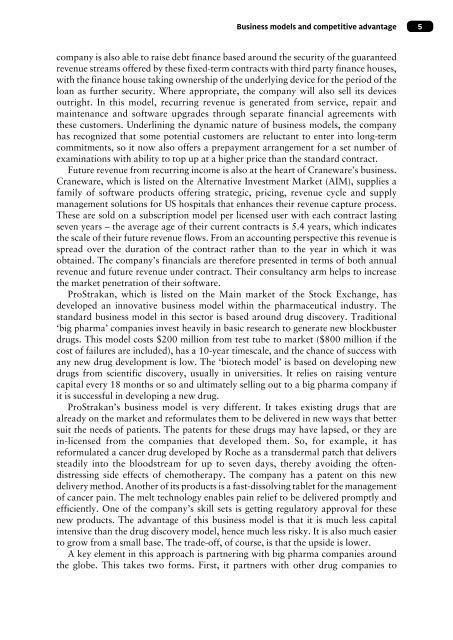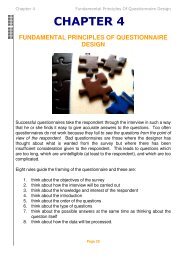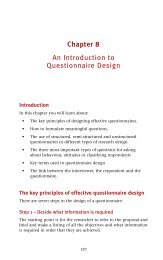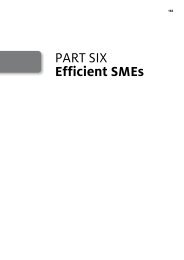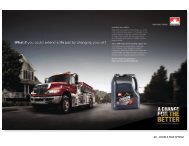The growing business handbook : inspiration and advice ... - Sparkler
The growing business handbook : inspiration and advice ... - Sparkler
The growing business handbook : inspiration and advice ... - Sparkler
You also want an ePaper? Increase the reach of your titles
YUMPU automatically turns print PDFs into web optimized ePapers that Google loves.
Business models <strong>and</strong> competitive advantage<br />
5<br />
company is also able to raise debt finance based around the security of the guaranteed<br />
revenue streams offered by these fixed-term contracts with third party finance houses,<br />
with the finance house taking ownership of the underlying device for the period of the<br />
loan as further security. Where appropriate, the company will also sell its devices<br />
outright. In this model, recurring revenue is generated from service, repair <strong>and</strong><br />
maintenance <strong>and</strong> software upgrades through separate financial agreements with<br />
these customers. Underlining the dynamic nature of <strong>business</strong> models, the company<br />
has recognized that some potential customers are reluctant to enter into long-term<br />
commitments, so it now also offers a prepayment arrangement for a set number of<br />
examinations with ability to top up at a higher price than the st<strong>and</strong>ard contract.<br />
Future revenue from recurring income is also at the heart of Craneware’s <strong>business</strong>.<br />
Craneware, which is listed on the Alternative Investment Market (AIM), supplies a<br />
family of software products offering strategic, pricing, revenue cycle <strong>and</strong> supply<br />
management solutions for US hospitals that enhances their revenue capture process.<br />
<strong>The</strong>se are sold on a subscription model per licensed user with each contract lasting<br />
seven years – the average age of their current contracts is 5.4 years, which indicates<br />
the scale of their future revenue flows. From an accounting perspective this revenue is<br />
spread over the duration of the contract rather than to the year in which it was<br />
obtained. <strong>The</strong> company’s financials are therefore presented in terms of both annual<br />
revenue <strong>and</strong> future revenue under contract. <strong>The</strong>ir consultancy arm helps to increase<br />
the market penetration of their software.<br />
ProStrakan, which is listed on the Main market of the Stock Exchange, has<br />
developed an innovative <strong>business</strong> model within the pharmaceutical industry. <strong>The</strong><br />
st<strong>and</strong>ard <strong>business</strong> model in this sector is based around drug discovery. Traditional<br />
‘big pharma’ companies invest heavily in basic research to generate new blockbuster<br />
drugs. This model costs $200 million from test tube to market ($800 million if the<br />
cost of failures are included), has a 10-year timescale, <strong>and</strong> the chance of success with<br />
any new drug development is low. <strong>The</strong> ‘biotech model’ is based on developing new<br />
drugs from scientific discovery, usually in universities. It relies on raising venture<br />
capital every 18 months or so <strong>and</strong> ultimately selling out to a big pharma company if<br />
it is successful in developing a new drug.<br />
ProStrakan’s <strong>business</strong> model is very different. It takes existing drugs that are<br />
already on the market <strong>and</strong> reformulates them to be delivered in new ways that better<br />
suit the needs of patients. <strong>The</strong> patents for these drugs may have lapsed, or they are<br />
in-licensed from the companies that developed them. So, for example, it has<br />
reformulated a cancer drug developed by Roche as a transdermal patch that delivers<br />
steadily into the bloodstream for up to seven days, thereby avoiding the oftendistressing<br />
side effects of chemotherapy. <strong>The</strong> company has a patent on this new<br />
delivery method. Another of its products is a fast-dissolving tablet for the management<br />
of cancer pain. <strong>The</strong> melt technology enables pain relief to be delivered promptly <strong>and</strong><br />
efficiently. One of the company’s skill sets is getting regulatory approval for these<br />
new products. <strong>The</strong> advantage of this <strong>business</strong> model is that it is much less capital<br />
intensive than the drug discovery model, hence much less risky. It is also much easier<br />
to grow from a small base. <strong>The</strong> trade-off, of course, is that the upside is lower.<br />
A key element in this approach is partnering with big pharma companies around<br />
the globe. This takes two forms. First, it partners with other drug companies to


